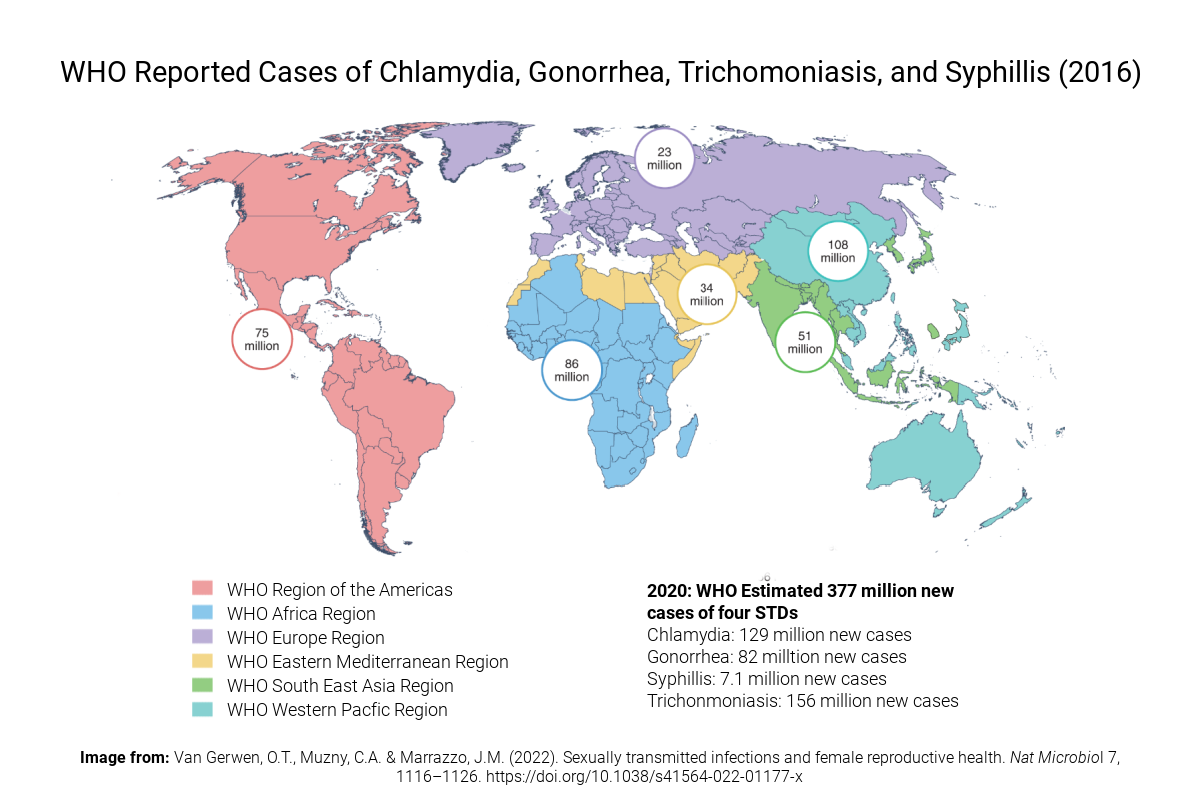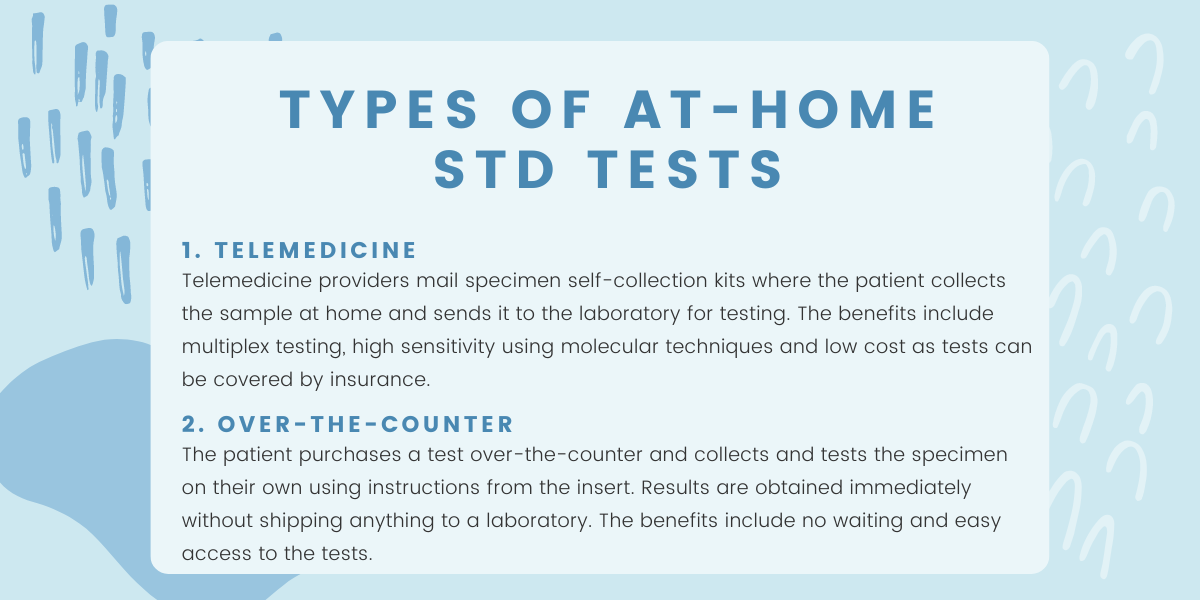Early diagnosis for STDs is a key factor to better health outcomes, however, research shows that social stigma creates a major barrier to testing for sexually transmitted diseases. In recent years, at-home testing for STDs has become more common, increasing the accessibility and appeal to individuals who would otherwise be reluctant to test. As the rates of STDs continue to increase globally, home testing will hopefully help encourage earlier diagnoses which will in turn, reduce the spread of these diseases.1
STDs are on the Rise
More than 35 bacterial, viral, and parasitic pathogens have been identified as sexually transmissible, and more than 1 million STDs are acquired every day worldwide, the majority of which are asymptomatic2. They are among the most common infectious diseases reported around the globe3 and the World Health Organization (WHO) estimated in 2016 that there are an estimated 374 million new infections every year of one of four curable STIs: chlamydia, gonorrhea, syphilis and trichomoniasis. In the United States alone, the overall number of reported STDs has been on the rise since 2014 and shows no sign of slowing, with gonorrhea increasing by 74% since 20172. Although most STDs are not life-threatening, they result in a substantial burden of diseases,4 and with STDs increasing globally, the WHO is calling for better access to testing and diagnostic services5.
Global Prevalence of Chlamydia, Gonorrhea, Trichomoniasis and Syphilis

Image from: Van Gerwen, O.T., Muzny, C.A. & Marrazzo, J.M. (2022). Sexually transmitted infections and female reproductive health. Nat Microbiol 7,1116–1126. https://doi.org/10.1038/s41564-022-01177-x
COVID Spurred a Self-Testing Revolution
The COVID pandemic spurred a self-testing revolution6, with self-testing ranking as the most preferred form of testing for COVID-197. This newly developed comfort for specimen self-collection and analysis has created an overall desire for more home tests for various health conditions including sexually transmitted diseases (STDs). Given that self-collection provides privacy, convenience and better accessibility, making it easier for people to get tested, governments are now targeting point-of-care and at-home test for STDS in the hope that they will reduce the overall spread of these diseases8.
How do At-Home STD Tests Work?
Home-based testing for STDs includes both self-collected mail-in specimens, and rapid assays that are sold over the counter (OTC) or ordered by mail8. Studies examining the popularity of STD home testing have shown that the testing rate is eleven times higher compared to clinic-based testing, demonstrating the dramatic preference for specimen self-collection9.

The type of specimen required for a test depends on the disease – chlamydia, gonorrhea and trichomoniasis typically require a vagina/urethral swab or urine sample, while HIV, syphilis, and hepatitis C generally require a finger prick (blood sample). Some tests for Chlamydia, gonorrhea and HIV only need an oral swab which is even more self-collection-friendly10.
The Growing At-Home STD Market
According to Amesh Adalja, M.D., a senior scholar at the Johns Hopkins University Center for Health Security, the STD epidemic is “out of control. We know we are missing diagnoses. We know that contact tracing is happening late or not at all. If we’re really serious about tackling the STD crisis, we have to get more people diagnosed.” Encouragingly in the U.S., several state public health departments, including Alabama, Alaska and Maryland have started mailing free STD test kits to residents. Universities and nonprofits are also spearheading at-home testing efforts11. As dozens of commercial enterprises start jumping into or ramping up direct-to-consumer tests for STDs, newer tests that set a new bar in at-home STD testing11, are expected to improve consumer confidence and further encourage home testing.
As a whole, the recent July 2023 guidelines released by the WHO aimed at improving testing and diagnosis of STDs6 in combination with the strong growth anticipated in the home testing market (CAGR of 10.5% increase from 2022 to 2031)12, the STD at-home testing market is predicted to expand with next-generation tests that are easy to use and highly accurate.
Meridian’s STD Home-Testing Reagent Solutions
Meridian is a leader in innovative molecular master mixes, and its Specimen-specific™ range of qPCR and LAMP mixes are ideal for extraction-free, sensitive amplification from saliva, urine or blood. These reagents, combined with Meridian’s extensive menu of highly sensitive antibody and antigen pairs to STDs provide companies looking to develop at-home STD assays, a single reliable vendor to support their assay development needs.
Interested to learn more about the applications and performance of Specimen-specific™ mixes for saliva samples? Download a copy of our whitepaper “ Saliva Specimen-specific™ Master Mixes for Multiplex.
References:
- Lee, A.S.D., Cody, S.L.. (2020). The Stigma of Sexually Transmitted Infections. Nurs. Clin. North Am. 55(3):295-305. https://doi.org/10.1016/j.cnur.2020.05.002
- As STDs proliferate, companies rush to market at-home test kits. But are they reliable? Liz Szabo, Kaiser Health News Nov 21, 2022. Fierce Biotech
- WHO Sexually transmitted infections (STIs) Fact Sheet (2023). Retrieved from: https://www.who.int/news-room/fact-sheets/detail/sexually-transmitted-infections-(stis)#:
- Fu. L., et al. (2022) Incidence Trends of Five Common Sexually Transmitted Infections Excluding HIV From 1990 to 2019 at the Global, Regional, and National Levels: Results From the Global Burden of Disease Study 2019. Front. Med. 9:851635. https://doi.org/10.3389/fmed.2022.851635
- Chesson, H.W., Mayaud, P., Aral, S.O. Sexually Transmitted Infections: Impact and Cost-Effectiveness of Prevention. Major Infectious Diseases. 3rd edition. (Washington,DC, The International Bank for Reconstruction and Development, 2017) https://doi.org/10.1596/978-1-4648-0524-0_ch10
- WHO releases new guidance to improve testing and diagnosis of sexually transmitted infections (2023). Retrieved from: https://www.who.int/news/item/24-07-2023-who-releases-new-guidance-to-improve-testing-and-diagnosis-of-sexually-transmitted-infections#:
- Katy McLaughlin “COVID-19: Implications for business” April 13, 2022. Accessed Sept 4 2023.
- Mehta, Parang. “What to Know About At-Home STD Tests.” WebMed. January 14, 2023. Accessed Sept 4 2023.
- Shih, S.L., Graseck, A.S., Secura, G.M., Peipert, J.F. (2011). Screening for sexually transmitted infections at home or in the clinic? Curr Opin Infect Dis.;24(1):78-84. https://doi.org/10.1097/QCO.0b013e32834204a8
- Mayo Clinic Staff. “STD testing: What’s right for you?” Myo Clinic. Accessed Sept 4 2023.
- Tucker, J.D., Bien, C.H., Peeling, R.W. (2013) Point-of-care testing for sexually transmitted infections: recent advances and implications for disease control. Curr Opin Infect Dis.;26(1):73-9. https://doi.org/10.1097/QCO.0b013e32835c21b0
- Emily Hendersen. “As STDS proliferate, companies rush to market at-home test kits. But are they reliable?” News-Medical.Net. Nov 20, 2022 Accessed Sept 4 2023.
- “At-Home Testing Market to Grow USD 45,582.24 Million by 2031 at a CAGR of 10.5%” | Valuates Reports 17 Jan, 2023. Accessed Sept 4 2023.